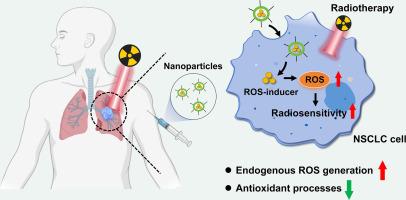Enhancing the sensitivity of radiotherapy in non-small cell lung cancer through nanotechnology-mediated reactive oxygen species generation
IF 23.5
1区 化学
Q1 CHEMISTRY, INORGANIC & NUCLEAR
引用次数: 0
Abstract
Radiotherapy (RT) is the cornerstone treatment for non-small cell lung cancer (NSCLC); however, the intrinsic radiation resistance of NSCLC and the inherent limitations of RT frequently lead to suboptimal therapeutic outcomes and poor clinical prognoses. RT primarily eliminates tumors by generating reactive oxygen species (ROS), which trigger oxidative cell death. Exogenous ROS-inducing agents can amplify this effect by exceeding the oxidative stress threshold in cancer cells, potentially enabling dose reduction and minimizing damage to surrounding healthy tissue. Despite this potential, conventional ROS inducers are hampered by poor solubility, low targeting specificity, and systemic toxicity, all of which limit their clinical applicability. Recent advances in nanomedicine have facilitated the development of nanotechnology-based strategies for ROS generation, offering promising alternatives to overcome these limitations. This review elucidates the mechanisms of ROS-mediated cell death and identifies key targets within the redox homeostasis network. It also evaluates therapeutic strategies for modulating these targets and highlights the advantages of nanodelivery systems, focusing on material properties, mechanistic insights, recent innovations, and the respective strengths and limitations of various ROS-generating nanoplatforms in radiosensitizing NSCLC. Finally, the review discusses future perspectives and outstanding challenges, providing a conceptual framework for the clinical translation of ROS-based radiosensitization strategies in NSCLC therapy.

通过纳米技术介导的活性氧生成增强非小细胞肺癌放疗的敏感性
放疗(RT)是非小细胞肺癌(NSCLC)的基础治疗;然而,NSCLC固有的放射耐药和RT的固有局限性经常导致治疗结果不理想和临床预后差。RT主要通过产生活性氧(ROS)来消除肿瘤,ROS会引发氧化性细胞死亡。外源性ros诱导剂可以通过超过癌细胞的氧化应激阈值来放大这种效应,从而潜在地减少剂量并最大限度地减少对周围健康组织的损害。尽管具有这种潜力,但传统的ROS诱导剂存在溶解度差、靶向特异性低和全身毒性等问题,限制了其临床应用。纳米医学的最新进展促进了基于纳米技术的ROS生成策略的发展,为克服这些限制提供了有希望的替代方案。本文综述了ros介导的细胞死亡机制,并确定了氧化还原稳态网络中的关键靶点。它还评估了调节这些靶点的治疗策略,并强调了纳米递送系统的优势,重点关注材料特性、机制见解、最新创新以及各种ros生成纳米平台在放射致敏NSCLC中的各自优势和局限性。最后,本文讨论了未来的前景和突出的挑战,为非小细胞肺癌治疗中基于ros的放射增敏策略的临床转化提供了一个概念性框架。
本文章由计算机程序翻译,如有差异,请以英文原文为准。
求助全文
约1分钟内获得全文
求助全文
来源期刊

Coordination Chemistry Reviews
化学-无机化学与核化学
CiteScore
34.30
自引率
5.30%
发文量
457
审稿时长
54 days
期刊介绍:
Coordination Chemistry Reviews offers rapid publication of review articles on current and significant topics in coordination chemistry, encompassing organometallic, supramolecular, theoretical, and bioinorganic chemistry. It also covers catalysis, materials chemistry, and metal-organic frameworks from a coordination chemistry perspective. Reviews summarize recent developments or discuss specific techniques, welcoming contributions from both established and emerging researchers.
The journal releases special issues on timely subjects, including those featuring contributions from specific regions or conferences. Occasional full-length book articles are also featured. Additionally, special volumes cover annual reviews of main group chemistry, transition metal group chemistry, and organometallic chemistry. These comprehensive reviews are vital resources for those engaged in coordination chemistry, further establishing Coordination Chemistry Reviews as a hub for insightful surveys in inorganic and physical inorganic chemistry.
 求助内容:
求助内容: 应助结果提醒方式:
应助结果提醒方式:


